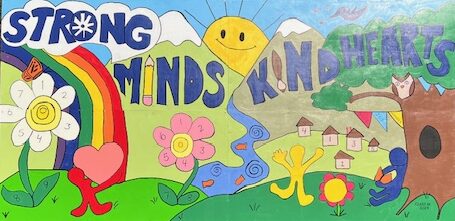
Spring has sprung–Happy May! Here is a peek into some Lower and Middle School artworks. Also, please be on the look out for your student’s Art Portfolio in the coming weeks. Your child will be bringing home a collection of their artwork from the school year.
Kindergarten
HOT DOGS, COOL CATS: George Rodrigue was born and raised in southwest Louisiana, “Cajun Country,” George Rodrigue preserved on his canvas what he feared was his dying heritage — including its land, people, traditions and mythology. It was a Cajun legend, the loup-garou, that spawned his most famous series, The Blue Dog. Kindergarten students learned about artist George Rodrigue and his creation of Blue Dog. After reading, Why is Blue Dog Blue? Students created their own inspired warm and cool dog and cat composition and after we discussed color schemes and color temperature.
First Grade
JOAN MIRÓ MAGICAL CREATURES: Joan Miró was a Spanish artist famous for combining abstract art with surrealism. He worked in a variety of media. Not only did he produce paintings and drawings, his body of work includes collages, murals, tapestries, and sculptures. Students took inspiration from Miró’s body of work and created their own combined abstract-surrealist figure highlighting a variety of symbols in the style of Miró .
Second Grade
PAUL KLEE CAT and BIRD: Cat and Bird is a painting by Swiss German painter Paul Klee, created in 1928. It was made when Klee was a teacher at the Bauhaus Dessau. The painting depicts the wide face of a stylized cat with a small bird perched on its forehead. It is held in the Museum of Modern Art, in New York. Students examined Klee’s work and created their own composition focusing on symmetry and balance.
Third Grade
NATIVE AMERICAN INSPIRED WEAVINGS: According to Navajo tradition, weaving is the most ancient and sacred practice of their people. Two spirits, the Spider People, brought hemp seeds to the Navajo. Spider Man taught them to make the loom, while Spider Woman taught them how to weave so that they could always provide for themselves. Third grade students took inspiration from this tradition and created these wonderful woven wall hangings.
Fourth Grade
CHINESE SCROLLS: A hanging scroll is one of the many traditional ways to display and exhibit East Asian painting and calligraphy. The hanging scroll was displayed in a room for appreciation; it is to be distinguished from the handscroll, which was narrower and designed to be viewed flat on a table in sections and then stored away again. Students used sumi brushes and ink to create these wonderful cherry blossom tree scroll designs.
Fifth Grade
Gyotaku Prints: Gyotaku (from gyo “fish” + taku “stone impression“) is the traditional Japanese method of printing fish, a practice which dates back to the mid-1800s. This form of nature printing was used by fishermen to record their catches, but has also become an art form of its own. The gyotaku method of printmaking uses fish, sea creatures, or similar subjects as its “printing plates“. Prints are made using sumi ink and washi paper. It is rumored that samurai would settle fishing competitions using gyotaku prints. This original form of gyotaku, as a recording method for fishermen, is still utilized today, and can be seen hanging in tackle shops in Japan.
Sixth Grade
ROCOCO INSPIRED NEEDLE FELTED SPRING EGGS: Rococo art, by nature, was elaborate, playful, filled with delicate colors, and often witty. Rococo is an artistic style which originated in the 18th century in France. Students created these wonderful Rococo inspired spring eggs using the art of needle felting. Needle Felting is the process of transforming wool into 3D objects using a barbed needle. When you felt wool, you’re agitating the fibers so they bond together, creating a solid fabric. Students adorned their springtime eggs with a variety of designs. From cherry blossom trees, to constellations. Once completed they gathered to hang on a birch tree.
Seventh Grade
PABLO PICASSO CUBIST FACES: Students learned about artist Pablo Picasso and his Cubist art movement. Students took inspiration and created their own deconstructed faces. Cubism was a revolutionary new approach to representing reality invented in around 1907–08 by artists Pablo Picasso and Georges Braque. They brought
different views of subjects (usually objects or figures) together in the same picture,
resulting in paintings that appear fragmented and abstracted.
Eighth Grade
COLLABORATIVE BALL WALL MURAL: Each year the graduating class creates a Legacy Art Project leaving their mark and beautifying our campus! This year students created a Ball Wall Mural. Students worked collaboratively creating the mural to include images and graphics that represent our school’s Core Academics, Core Virtues, Co-Curriculars, and school motto and mascot. There are also some interactive features to the wall such as, a point game system using a ball, a tic-tac-toe game board, mindfulness spirals in the river as well as a high-five to start your day! Once it was completed, the mural was dedicated to Mr. Martin who built the wall in the summer of 2008 with funds raised by Ms. Martin’s Second Grade A Egg company.




